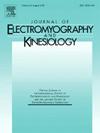Impact of different ranges of motion in the prone barbell row on muscle excitation
IF 2
4区 医学
Q3 NEUROSCIENCES
引用次数: 0
Abstract
This study investigated muscle excitation via surface electromyography (sEMG) during different ranges of motion (ROMs) in the prone barbell row. Sixteen resistance-trained males performed a 10-repetition maximum (10RM) across three ROMs: full, upper half, and lower half. Time under tension was standardized at 2 s for both the concentric and eccentric phases. SEMG measurements were taken for the trapezius transversus (TT), rear deltoid (RD), latissimus dorsi (LD) and biceps brachii (BB). Mean sEMG amplitude and peak sEMG amplitude were analyzed. The LD showed significantly higher mean muscle excitation in the upper-half ROM compared to both the lower-half ROM (p < 0.001, d = − 0.59) and full ROM (p < 0.001, d = − 0.58). The TT exhibited significantly lower peak excitation in the upper-half ROM compared to the lower-half ROM (p = 0.042, d = 0.42) and full ROM (p = 0.013, d = 0.54). For the other muscles, no significant difference between the ROMs was found. The effect of ROM during the prone barbell row exercise on muscle excitation was of a medium magnitude only, as well as inconsistent, suggesting that ROM adjustments with standardized time under tension have limited impact on overall muscle activation.
俯卧杠铃排不同运动范围对肌肉兴奋的影响
本研究通过表面肌电图(sEMG)研究了俯卧杠铃行不同运动范围(ROMs)时的肌肉兴奋情况。16名受过阻力训练的男性在三个rom中进行了10次最大重复(10RM):完整,上半部分和下半部分。在拉力下,同心相和偏心相的时间都标准化为2s。肌电图测量斜方肌横肌(TT)、后三角肌(RD)、背阔肌(LD)和肱二头肌(BB)。分析表面肌电信号平均振幅和峰值振幅。LD显示上半部分ROM的平均肌肉兴奋程度明显高于下半部分ROM (p <;0.001, d = - 0.59)和全ROM (p <;0.001, d =−0.58)。与下半部分ROM (p = 0.042, d = 0.42)和全ROM (p = 0.013, d = 0.54)相比,TT在上半部分ROM中表现出明显较低的峰值兴奋。对于其他肌肉,rom之间没有发现显著差异。俯卧杠铃排运动中ROM对肌肉兴奋的影响仅为中等程度,且不一致,这表明在紧张状态下以标准化时间调整ROM对整体肌肉激活的影响有限。
本文章由计算机程序翻译,如有差异,请以英文原文为准。
求助全文
约1分钟内获得全文
求助全文
来源期刊
CiteScore
4.70
自引率
8.00%
发文量
70
审稿时长
74 days
期刊介绍:
Journal of Electromyography & Kinesiology is the primary source for outstanding original articles on the study of human movement from muscle contraction via its motor units and sensory system to integrated motion through mechanical and electrical detection techniques.
As the official publication of the International Society of Electrophysiology and Kinesiology, the journal is dedicated to publishing the best work in all areas of electromyography and kinesiology, including: control of movement, muscle fatigue, muscle and nerve properties, joint biomechanics and electrical stimulation. Applications in rehabilitation, sports & exercise, motion analysis, ergonomics, alternative & complimentary medicine, measures of human performance and technical articles on electromyographic signal processing are welcome.

 求助内容:
求助内容: 应助结果提醒方式:
应助结果提醒方式:


